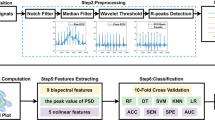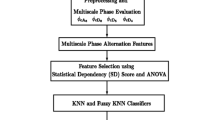Abstract
Heart is an important and hardest working muscular organ of the human body. Inability of the heart to restore normal perfusion to the entire body refers to cardiac failure, which then with symptoms results in manifestation of congestive heart failure (CHF). Impairment in systolic function associated with chronic dilation of left ventricle is referred as dilated cardiomyopathy (DCM). The clinical examination, surface electrocardiogram (ECG), chest X-ray, blood markers and echocardiography play major role in the diagnosis of CHF. Though the ECG manifests chamber enlargement changes, it does not possess sensitive marker for the diagnosis of DCM, whereas echocardiographic assessment can effectively reveal the presence of asymptomatic DCM. This work proposes an automated screening method for classifying normal and CHF echocardiographic images affected due to DCM using variational mode decomposition technique. The texture features are extracted from variational mode decomposed image. These features are selected using particle swarm optimization and classified using support vector machine classifier with different kernel functions. We have validated our experiment using 300 four-chamber echocardiography images (150: normal, 150: CHF) obtained from 50 normal and 50 CHF patients. Our proposed approach yielded maximum average accuracy, sensitivity and specificity of 99.33%, 98.66% and 100%, respectively, using ten features. Thus, the developed diagnosis system can effectively detect CHF in its early stage using ultrasound images and aid the clinicians in their diagnosis.






Similar content being viewed by others
References
Nichols M, Townsend N, Luengo-Fernandez R, Leal J, Gray A, Scarborough P, Rayner M (2012) European cardiovascular disease statistics 2012. Brussels, European Society of Cardiology, Sophia Antipolis, European Heart Network
Mann DL, Zipes DP, Libby P, Bonow RO (2005) Braunwald’s heart disease: a text book of cardiovascular medicine, 10th edn. W.B. Saunders, Philadelphia, p 1
Wenger NK, Abelman WH, Roberts WC, Hurst JW (1990) The heart, arteries and veins, 7th edn. McGraw-Hill, New York
Acharya UR, Kannathal N, Hua LM, Yi LM (2005) Study of heart rate variability signals at sitting and lying postures. J Bodyw Mov Ther 9(2):134–141
Asyali MH (2003) Discrimination power of long-term heart rate variability measures. In: Engineering in medicine and biology society: proceeding of the 25th annual international conference of the IEEE EMBS, Cancum
Isler Y, Kuntalp M (2007) Combining classical HRV indices with wavelet entropy measures improves to performance in diagnosing congestive heart failure. Comput Biol Med 37:1502–1510
Hossen A, Al-Ghunaimi B (2007) A wavelet-based soft decision technique for screening of patients with congestive heart failure. Biomed Signal Process Control 2:135–143
Pecchia L, Melillo P, Sansone M, Bracale M (2011) Discrimination power of short-term heart rate variability measures for CHF assessment. IEEE Trans Inf Technol Biomed 15(1):40–46
Yu S-N, Lee M-Y (2012) Conditional mutual information-based feature selection for congestive heart failure recognition using heart rate variability. Comput Methods Programs Biomed 108(1):299–309
Masetic Z, Subasi A (2016) Congestive heart failure detection using random forest classifier. Comput Methods Programs Biomed 130:54–64
Acharya UR, Fujita H, Sudarshan VK, Oh SL, Muhammad A, Koh JEW, Tan JH, Chua CK, Chua KP, Tan RS (2016) Application of empirical mode decomposition (EMD) for automated identification of congestive heart failure using heart rate signals. Neural Comput Appl. doi:10.1007/s00521-016-2612-1
Pai VB, Nahata MC (2000) Cardiotoxicity of chemotherapeutic agents: incidence treatment and prevention. Drug Saf 22(4):263–302
Feigenbaum H, Armstrong WF, Ryan T (2004) Feigenbaum’s echocardiography, 6th edn. Lippincott, Williams & Wilkins, Philadelphia
Cleland JG, Dargie HJ, Ford I (1987) Mortality in heart failure: clinical variables of prognostic value. Br Heart J 58:572–582
Wenger NK, Abelman WH, Roberts WC, Hurst JW (1990) The heart, arteries and veins, 7th edn. McGraw-Hill, New York, pp 1278–1347
Middlekauff HR, Stevenson WG, Stevenson LW (1991) Prognostic significance of atrial fibrillation in advanced heart failure. A study of 390 patients. Circulation 84:40–48
Williams JF (1995) Guidelines for the evaluation and management of heart failure. Report of the American College of Cardiology/American Heart Association Task Force on Practice Guidelines (Committee on Evaluation and Management of Heart Failure). J Am Coll Cardiol 26:1376–1398
Solomon SD, Anavekar N, Skali H, McMurray JJV, Swedberg K, Yusuf S, Granger CB, Michelson EL, Wang D, Pocock S, Pfeffer MA (2005) Influence of ejection fraction on cardiovascular outcomes in a broad spectrum of heart failure patients. Circulation 112(24):3738–3744
Zuiderveld K (1994) Contrast limited adaptive histogram equalization, graphic gems IV. Academic Press Professional, San Diego, pp 474–485
Keys R (1981) Cubic convolution interpolation for digital image processing. IEEE Trans Acoust Speech Signal Process 29(6):1153–1160
Dragomiretskiy K, Zosso D (2015) Two dimensional variational mode decomposition. In: 10th international conference, EMMCVPR, pp 197–208
Hestenes MR (1969) Multiplier and gradient methods. J Optim Theory Appl 4(5):303–320
Rockafellar RT (1973) A dual approach to solving nonlinear programming problems by unconstrained optimization. Math Program 5(1):354–373
Bertsekas DP (1982) Constrained optimization and lagrange multiplier methods, vol 1. Academic Press, Boston
Hassanpour H, Samadiani N, Salehi SMM (2015) Using morphological transforms to enhance the contrast of medical images. Egypt J Radiol Nucl Med 46(2):481–489
Haralick RM, Shanmugam K, Dinstein I (1973) Textural features of image classification. IEEE Trans Syst Man Cybern 3(6):610–621
Soh L, Tsatsoulis C (1999) Texture analysis of SAR sea ice imagery using gray level co-occurrence matrices. IEEE Trans Geosci Remote Sens 37(2):780–795
Clausi DA (2002) An analysis of co-occurrence texture statistics as a function of grey level quantization. Can J Remote Sens 28(1):45–62
Acharya UR, Chua KC, Ng EYK, Wei W, Chee C (2008) Application of higher order spectra for the identification of diabetes retinopathy stages. J Med Syst 32(6):481–488
Acharya UR, Dua S, X Du, Chua CK (2011) Automated diagnosis of glaucoma using texture and higher order spectra features. IEEE Trans Inf Technol Biomed 15(3):449–455
Weszka JS, Rosenfield A (1976) An application of texture analysis to material inspection. Pattern Recognit 8(4):195–200
Galloway MM (1975) Texture classification using gray level run length. Comput Graph Image Process 4(2):172–179
Kennedy J, Eberhart R (1995) Particle swarm optimization. Proc IEEE Int Conf Neural Netw 4:1942–1948
Shi Y, Eberhart R (1998) A modified particle swarm optimizer. In: Proceedings of IEEE International CEC, pp 69–73
Kecman V (2001) Learning and soft computing. MIT Press, Cambridge
Salzberg SL (1997) On comparing classifiers: pitfalls to avoid and a recommended approach. Data Min Knowl Discov 1(3):317–328
Lin S-W, Ying K-C, Chen S-C, Lee Z-J (2008) Particle swarm optimization for parameter determination and feature selection of support vector machines. Expert Syst Appl 35:1817–1824
Acharya UR, Sree SV, Krishnan MMR, Molinari F, Saba L, Ho SYS, Ahuja AT, Ho SC, Nicolaides A, Suri JS (2012) Atherosclerotic risk stratification strategy for carotid arteries using texture-based features. Ultrasound Med Biol 38(6):899–915
Acharya UR, Ng EYK, Tan JH, Sree SV, Ng K-H (2012) An integrated index for the identification of diabetic retinopathy stages using texture parameters. J Med Syst 36(3):2011–2020
Raghavendra U, Acharya UR, Fujita H, Gudigar A, Tan JH, Chokkadi S (2016) Application of gabor wavelet and locality sensitive discriminant analysis for automated identification of breast cancer using digitized mammogram images. Appl Soft Comput 46:151–161
Author information
Authors and Affiliations
Corresponding author
Ethics declarations
Conflict of interest
None of the authors have any conflict of interest.
Appendix
Rights and permissions
About this article
Cite this article
Raghavendra, U., Acharya, U.R., Gudigar, A. et al. Automated screening of congestive heart failure using variational mode decomposition and texture features extracted from ultrasound images. Neural Comput & Applic 28, 2869–2878 (2017). https://doi.org/10.1007/s00521-017-2839-5
Received:
Accepted:
Published:
Issue Date:
DOI: https://doi.org/10.1007/s00521-017-2839-5




